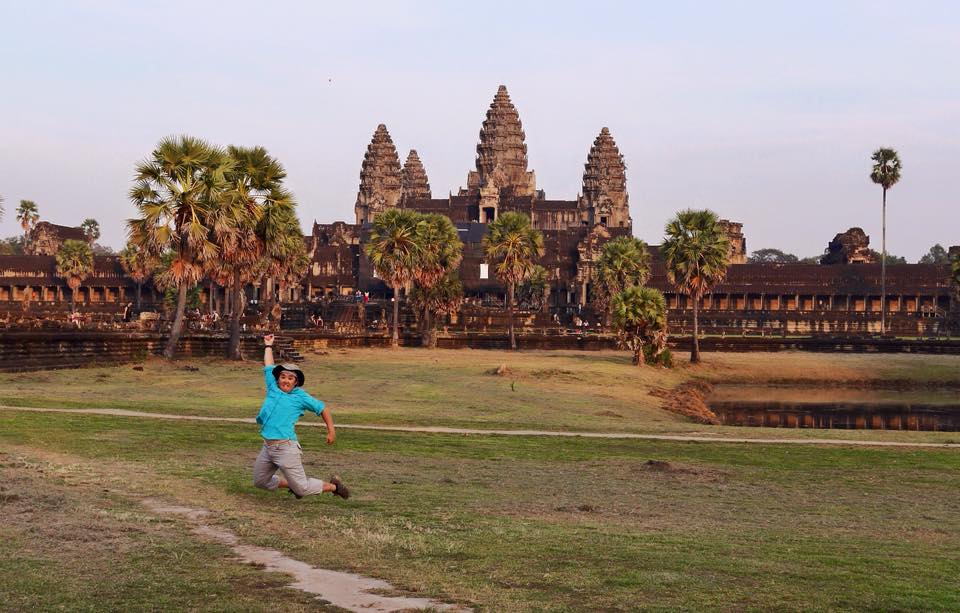Listed as one the Wonders of the World, Angkor is one of the most iconic landmarks in the world. Naturally it is a huge tourist attraction, so huge that the amount of tourists in Angkor can seem more overwhelming than the site itself. In fact, I have never been anywhere else yet with such a diverse concentration of people from around the world.
Many tourists also take Angkor for granted, underestimating the size and diversity of the site, and rely on tourist info or organized tours. Siem Reap itself is also extremely touristy and commercialised, and the authenticity of the Khmer experience can be drowned out by it.
I visited Angkor in December 2015 as part of my cycle trip across Cambodia. These are some of my travel hacks that you can use to plan a better Angkor experience.
Angkor Wat is not the only temple
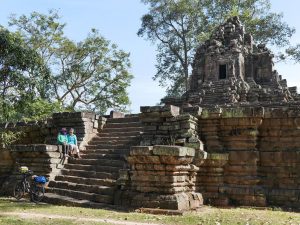
Many people may not be aware of this before coming to Angkor, but Angkor Wat is just one temple in a huge area called the Angkor Archaeological Park; the park includes more than 40 over temples and sites. The tour groups usually plough through a few popular temples, but there are actually many other quieter temples, usually around the North side of the park, that are equally as fascinating. In fact these temples have the advantage of being better for photographs because there is no one to block your shots!
Aside from the main temples, there are a scattering of archaeological sites all over the park, like small monuments, collapsed structures, brick remnants, etc. If you enjoy an Indiana Jones-esque treasure hunt, there is plenty to find outside the main thoroughfares. Also, the park itself is a beautiful natural enclosure, with trails that wind along waterways and through forests.
There are two more sites outside the Park, and they are worth it
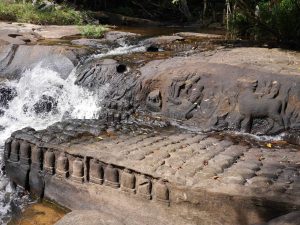
Unknown by many, there are two more sites that is covered under the Angkor Pass, but is situated outside the boundaries of the Angkor Archaeological Park. And both are worth the extra effort to get there. Tuks-tuks or taxis can be hired to reach these two sites.
Banteay Srei – located about 25km or 20 minutes’ drive outside Angkor Park. It is an average size complex, about one hour’s worth of exploration. The selling point of Banteay Srei is that the temple has one of the most intricate and well preserved wall carvings in the whole Angkor complex, and you can definitely see the difference once you have been to a few temples. The carvings are so intricate that they are almost 3D-like, and while viewing them one can’t help but marvel at the skills of these early artisans.
Kbal Spaen – located about 50km or 1 hour plus drive outside Angkor Park. This is one of my favourite sites as it is so different and unique. It is not a temple or building structure, but a site located in the Cambodian jungle. You have to hike uphill for about 30 minutes, tracing a river upstream. Once you arrive at a waterfall, you can start treasure hunting – spotting carvings of gods and animals on rocks that are scattered randomly around the site. The carvings could be on a rock wall, or on a boulder next to the river, or in the river itself. The other name for Kbal Spaen is “The River of a Thousand Lingas”, as there is a section of the riverbed covered with phallic structures. I find these the most fascinating, thinking of the technology required to stop the flow of the river to do these carvings and sculptures.
Get the three-day ticket (at least)
Admission passes to the Angkor Archaeological Park are available in one-day, three-days, or seven-days. It is best to get the three-day pass at the very least. Not only is Angkor Park itself big and vast, some of the main temples, like Angkor Wat, is a huge complex in itself, with lots of nooks and crannies to explore. These temples take 2-3 hours to explore on foot. A one-day pass will only allow you a whirlwind taste of the Angkor experience, without fully immersing in the majesty and history of the place.
I myself bought a 3-day pass. I used it for two full days in Angkor Park, and my third day was used for visiting Banteay Srei and Kbal Spaen. It was just the right amount of time for me to feel satisfied with my Angkor adventure.
Explore on a bicycle.
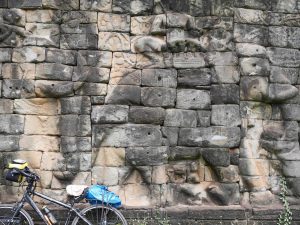
There are a couple ways that most people tour Angkor with – tour groups, and self-hired tuks-tuks on a daily basis. But from my experience neither one can beat exploring Angkor on a bicycle. You have the freedom to decide which sites to visit and when, choose to run away from the crowds when the trove of buses load in, and with a bike you have the flexibility to duck into the forest trails and have a quiet picnic next to a lake. The loop around the park also passes through local settlements and paddy fields and is a joy to ride.
A tuk-tuk will cost about USD20 per day, and it is not too bad if you have a group of four to share with for each vehicle. But cost-wise it is still cheaper to rent a bicycle. Many hotels and travel agencies in Siem Reap have bicycles for rent. It is worth paying a little more to get a better bike as some cheap (or free) options can be quite wonky. Cycling from Siem Reap to Angkor Park takes around 20 minutes and a loop around the park itself takes about 1 hour so a good bike is worth the investment. Or better yet if you have a folding bicycle at home, bring it with you!
Hire an interpretive guide, or use a good guide book.
The history behind Angkor is incredibly rich. Every temple has carvings and sculptures that contain stories and meanings, and just on the architecture itself there is plenty to talk about. It is worth hiring an experienced interpretive guide to walk you through the sites for a deeper understanding. Otherwise every temple and every site will seem like another pile of bricks to you.
OF course it might be costly to hire a guide if you are a solo traveller, or cycling. The cheap backpacker option is to buy a good interpretive guidebook. There are plenty of options on Amazon/internet. Street peddlers in Siem Reap have counterfeit copies for sale and these are NOT recommended (Authors need to eat too!).
Utilize the whole day in the Park
It is possible, and recommended, to fully utilize the whole day in the park. Arrive early for the sunrise, either over Angkor Wat or Srah Srang, and stay until sunset at Phnom Bakheng or Pre Rup. Food is not a problem as there are plenty of food stalls all over the park, especially in the main thoroughfares like Terrace of the Elephants. Prices are relatively the same as those in Siem Reap, touristy but save the cost of travelling to and fro the city. Toilets are also easily found in the park, and they are usually quite clean.
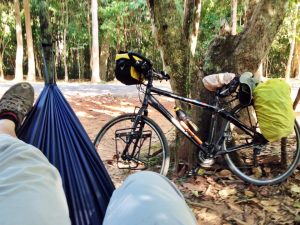
Bring a hammock to recover from Temple-itis
At some point during a whole day of temple exploration, one will suffer the effects of Temple-itis – fatigue from the physical exertion, and seeing too many temples at a short span of time that it all becomes a blur. So to escape the afternoon heat and to take a break, string up a hammock between two trees and go for a snooze. As mentioned before the park is vast, with lots of beautiful forests in between, so looking for a quiet spot with suitable trees is not difficult at all. No hammock? Bring a beach towel/mat and have a lie down!
Make the most of the Quiet Hour
Most tourist groups in Angkor work like this – the throngs will arrive early in the morning for the sunrise viewing. They are then ferried back to their hotels for breakfast, before returning mid-morning to continue their tours. This means that the quietest hour in Angkor Park is between sunrise and mid-morning, 7am-8am -ish. I would recommend choosing one of the “popular” temples that interests you the most, and visit that site during the Quiet Hour. The air still has the morning crispness, the temperature is still cool, and the sites look most bewitching when there are no tourists crawling all over them. I visited Bayon, the temple of many faces, for my Quiet Hour and it was a very surreal and immersing exploration.
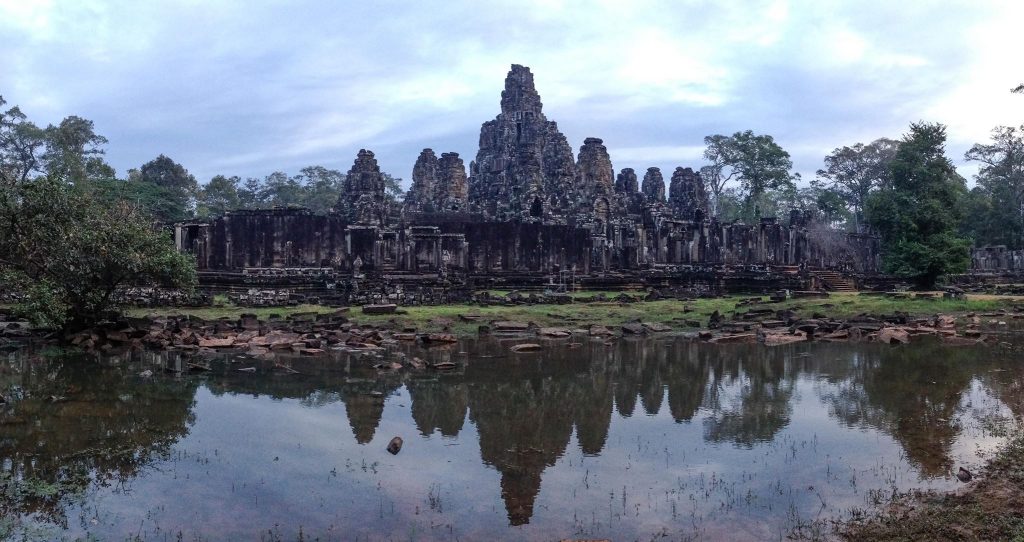
Options for sunset viewing besides Phnom Bakheng
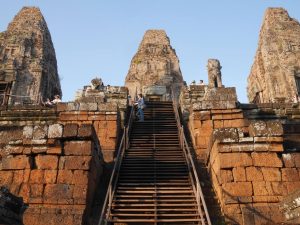
Phnom Bakheng is the go-to choice for sunset viewing for most tour groups, and the crowds seen queueing and trekking up the hill can be scary. These are some of my recommendations for an alternative sunset experience:
Pre Rup – A second choice to Phnom Bakheng, but with good views nonetheless. There is still a crowd, but not as huge and unwieldy as Phnom Bakheng.
Srah Srang – It is not a temple, but a reservoir lake. But because there are no tall buildings or trees around the lake, the water acts like huge mirror and reflects a huge expanse of sky. Both dawn and dusk colours at this lake is spectacular.
Angkor Wat – This may be a surprise choice for some, but Angkor Wat faces West, and therefore the golden dusk light falls directly on the complex every evening and has the best light of the day. If you are a photographer you will appreciate the value of this.
